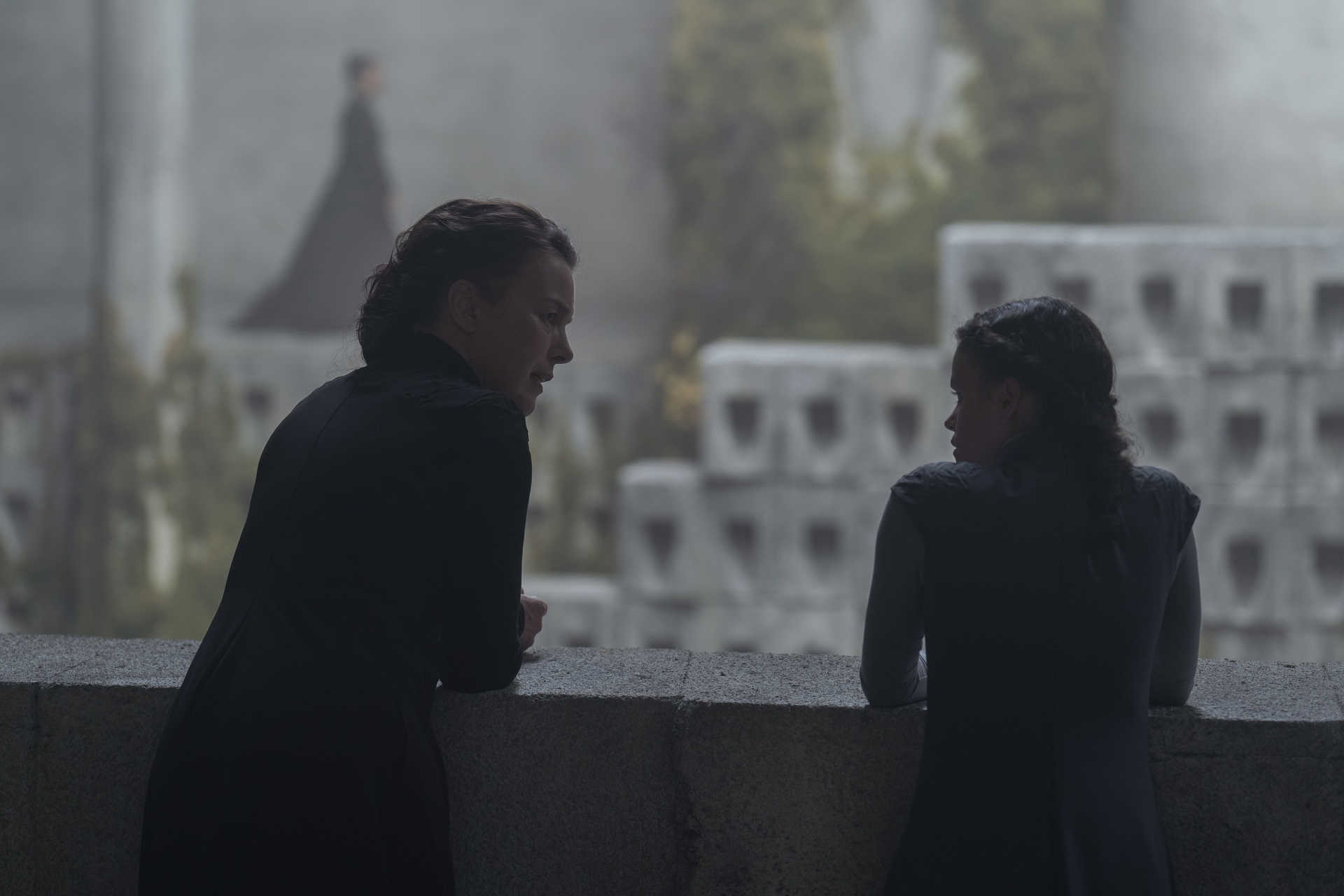
This post contains full spoilers for Dune: Prophecy episode 2.
“Two Wolves,” the second episode of Dune: Prophecy, offers more forward plot momentum than the series’ exposition-heavy premiere. But with the emphasis on action comes even more questions, as the show continues to reference aspects from the many millennia in the Dune timeline.
Once again, Den of Geek‘s here to explain some of the more confusing aspects of the episode and point to clues about Dune: Prophecy‘s central mystery, the identity of the prophesied Tiran-Arafel.
The Suk School
“Two Wolves” opens with Tula (Olivia Williams) welcoming a former sister who has left the order to join the Suk School. You might not recognize the name “Suk,” but you’ll probably notice the grey triangle on the doctor’s forehead. The same symbol appeared on Dr. Wellington Yueh in Dune, where he was played by Chang Chen.
Named for its founder Mohandas Suk, the Suk Medical School is the most respected medical institution in the Imperium. Because of the lack of machines in the world of Dune, only the Suk Doctors carry the medical knowledge necessary to protect the ruling classes. Thus, Suk Doctors enjoy a certain amount of autonomy within the Imperium, which helps explain Tula’s sense of gratitude when one arrived to examine the body of Mother Kesha.
The Agony and the Rossak Poison
The major conflict in “Two Wolves” involves Valya (Emily Watson) encouraging Lila (Chloe Lea) to experience the agony and access her genetic memories, sometimes referred to as “other memory” in the episode. To prepare for the agony, we see Tula preparing something called a Rossak poison.
Fans of the Denis Villeneuve movies might recall something called the Spice Agony, which Paul undergoes in Dune: Part Two. Although the Sisters in Prophecy just refer to the agony, the basic process remains the same. In both the Agony and the Spice Agony, a subject drinks from the Water of Life, a poison from the a mixture of water and the bile of a sandworm on Arrakis. If the subject survives the poison, they emerge with special powers, including access to genetic memories.
The Sisterhood, and eventually the Bene Gesserit, use the Water of Life as part of their method of testing and confirming a Mother Superior. Candidates spend years preparing their minds and bodies with techniques to resist the poison. Before that, when the forerunners of the Sisterhood were members of a amalgam of Buddhism and Islam called the Zensunni, they used a poison derived from a plant called Rossak as part of their ritual.
Over the centuries, as the Zensunni changed into the Sisterhood, the Water of Life replaced the Rossak. But the older method isn’t completely forgotten, as Tula demonstrates.
Other Memory and Lila’s Vision
Lila’s experience with other memories represents the most striking part of Dune: Prophecy so far. We’ve seen elements of the process in Dune: Part Two, when Paul takes the Water of Life to become the Kwisatz Haderach and when Jessica speaks with the still unborn Alia. But “Two Wolves” gives viewers the first full depiction of the process.
As she makes her way through the agony, Lila sees herself in a vast cavern, surrounded by women in robes. These women represent all of Lila’s female ancestors, the people whose essence still lives within her.
The scene makes literal something only hinted at in Frank Herbert‘s books. Herbert generally depicts genetic memories through conversations between a living person and someone who died, as when the late Baron Harkonnen communicates with one of his grandchildren in the novel Children of Dune.
The more literal portrayal in Prophecy reminds viewers that memories aren’t just echoes in the mind of the living. Rather, they operate as distinct and full people, often with their own motivations. Furthermore, the dead person can even possess the living, asserting their memories over the living person’s consciousness to continue their own plots.
That threat manifests in “Two Wolves” when Lila sees not Mother Raquella, but rather Sister Dorotea (Camilla Beeput). We saw Sister Dorotea in the previous episode as a close confidante and potential heir to Raquella as Reverend Mother. Because Dorotea did not share her concern for stopping Tiran-Arafel, Valya killed her.
So when Dorotea has access to the present via Lila, she doesn’t miss the opportunity for revenge. She takes control of Lila and issues a warning to Tula and Valya, a threat that might continue even past Lila’s apparent death.
Aoife Hinds’ Sister Emeline’s Connection to Reyna Butler, Vorian Atreides, and the Battle of Corrin
The night before she endures the agony, Lila seeks console from her fellow acolyte Sister Emeline (Aoife Hinds). Emeline shares a story from her family’s past, about their service with Reyna Butler in the Battle of Corrin.
If the name “Butler” sounds familiar, it’s because we talked about it in last week’s explainer. Reyna Butler was the central figure in the Butlerian Jihad, an anti-machine religious fervor that came out of the war between humans and AIs. What began as a resistance changed into a powerful cult, as Reyna started the Cult of Serena, named for her great-grand-aunt Serena Butler. When the robot Erasmus killed Serena’s son, the latter fought back, sparking the war against the thinking machines.
The Battle of Corrin occurs approximately 120 years after Serena’s rebellion, and puts an end to machines and essentially begins the world of Herbert’s books. As outlined in the 2004 book Dune: The Battle of Corrin by Brian Herbert and Kevin J. Anderson, the Butlerian Jihad managed to destroy most thinking machines in the galaxy, driving the robot overmind Omnius and powerful cyborgs called Titans to the planet Corrino.
However, because humanity was still crippled by a massive pandemic released by Omnius, they could not take the planet. It took twenty years for humans to finish the work, after which the Omnius and the Titans were destroyed, effectively purging the galaxy of thinking machines. In the aftermath, Viceroy Faykan Butler changes his name to Faykan Corrino, becoming the first of the emperors in the line that will eventually include Javicco and, much later, Shaddam IV. Vorian Atreides establishes himself as a hero in the battle, while Abulurd Harkonnen betrays humanity to the machines.
At least, that’s the official story, a story that Valya Harkonnen despises as an Atriedes lie.
Lady Shannon Richese (Tessa Bonham Jones) and the Rebellion on Arakkis
During the sexposition scene between Constantine Corrino (Josh Heuston) and Lady Shannon Richese (Tessa Bonham Jones), the latter explains that the real power in the Imperium lies with whoever controls the desert planet, something everyone in the Great Houses and the Great Schools understands.
Lady Shannon’s statement tracks with the basic themes of Dune; “He who controls the spice controls the universe!” goes an unusually straightforward line from David Lynch’s adaptation. That conflict plays out in miniature in the alliance between Keiran Atreides (Chris Mason), a man called Horace (Sam Spruell), and the Fremen Mikaela (Shalom Brune-Franklin).
Mikaela’s bright blue eyes mark her as a native of Arrakis, as the coloring comes from exposure and addiction to the spice that flows through the air. Where other long-term residents of the planet, such as Baron Harkonnen in the films and potentially Desmond Hart in Prophecy, can dodge spice addiction by eating foods they import and avoiding prolonged exposure to the desert, Mikaela’s eye color shows that she’s been on the ground and with the people.
Although we learn that she’s secretly a member of the Sisterhood and works to advance Valya’s plots, Mikaela’s alliance with Keiran and Horace shows that already the Fremen, the natives of Arrakis, tire of the Imperium’s interference and will enter into allegiances to get their planet back.
Desmond Hart’s Powers, The Bene Tleilax, and Shai-Hulud
Like the preceding episode, “Two Wolves” ends with a shocking display of Desmond Hart’s powers. Sure, we see him (almost) toast someone alive again. But the real shock involves his second face off with Valya. The Mother Superior tries to use Voice on Desmond and force him to stab himself with his own blade, but he resists.
According to Desmond, he gained his powers after an encounter with a sandworm on Arrakis. “Shai-Hulud took my eye, and granted me the gift to see what even you cannot,” he tells Valya.
The Fremen call sandworms “Shai-Hulud” as part of their worship of the worm, a belief that the worm is the manifestation of their monotheistic god. The Dune movies show that few people survive encounters with the massive creatures, but also that the sandworms have powerful effects on the humans around them. After all, the Water of Life is partially derived from the bile of sandworms.
However, book readers may suspect another, less mystical force at play: the Bene Tleilax.
They may not have received the same attention as the Bene Gesserit or the Spacing Guild, but the Bene Tleilax are arguably the most important sub group in the Dune universe. Their creations are a constant across Frank Herbert’s books, despised by the rest of the universe but unavoidable with their skills.
The Bene Tleilax, or Tleilaxu as they’re usually called, are part of a patriarchal society on the planet Tleilax. Like the Bene Gesserit, the Tleilaxu seek to control the Imperium through their extreme genetic manipulation. These practices lead to the creation of Axlotl Tanks, through which the Masters grow gholas or clones. A ghola of a particular person close to Paul becomes a major reoccuring character throughout Herbert’s books (no spoilers on that here). The Tleilaxu also develop a method of shapeshifting, called “face dancing” in the world of Dune.
Both gholas and face dancers serve the ruling class on Tleilax, the Tleilaxu Masters. Although small in physical appearance, the Tleilaxu Masters have engineered themselves to have remarkable abilities, including a resistance to the Bene Gesserit’s power of Voice.
Because of their unethical experiments, the Tleilaxu are held in low regard by most in the Imperium. That’s particularly true of the Bene Gesserit, with whom the Bene Tleilax have a long-standing rivalry. Desmond openly admits his goal of wiping the Bene Gesserit from the Imperium, which sure sounds like the type of thing a Tleilaxu would like to see.
But is that enough to make him Tiran-Arafel?
The Prophecy of Tiran-Arafel
We saw Mother Raquella prophesy the coming of Tiran-Arafel in the first episode of Dune: Prophecy, but it’s easy to forget that moment among the many, many other things that happened. Thankfully, the second episode gives the moment a bit more space, when Tula tells Lila that Tiran-Arafel refers to a “tyrannical force” with which the Sisterhood must reckon.
The word “tyrant” has a lot of meaning for readers of Frank Herbert’s novels. Paul and Chani’s son Leto II is often described as “the Tyrant,” thanks to his unyielding rule over the Imperium. And because he melded with a sandworm to become the God Emperor of Dune, Leto II rules for over 3,000 years, during which he guides humanity on what he calls the Golden Path.
However, Leto II isn’t born until 10,000 years after the events of Prophecy, so it seems like a real stretch for Raquella to worry about him now.
Given Prophecy‘s proximity to the war against machines, Tiran-Arafel might have more to do with the robots thought destroyed during the Butlerian Jihad. We’ve already seen that Mother Raquella used a birthing matrix to engineer an ideal leader, and book readers know that the people on the planet Ix use some form of machines.
Furthermore, Dune: Prophecy might cite the novel Sisterhood of Dune (2012) as an inspiration, but that’s just one entry in a trilogy that includes Mentats of Dune (2014) and Navigators of Dune (2016). These books describe the early days of the Great Schools, and include the revelation that the Mentat school harbors a copy of the thinking machine Erasmus, the robot who killed Serena Butler’s child.
Could Tiran-Arafel be a machine, or a cyborg Titan, come back for revenge? Could Desmond Hart’s abilities be the result of machine interference, even more than the gift of the sandworm?
We won’t know until later episodes of Dune: Prophecy, and Den of Geek will be there to explain it all on the way.
Dune: Prophecy airs Sundays at 9pm EST on HBO and Max.
The post Dune: Prophecy Episode 2 Explained – Bene Tleilax, Tiran-Arafel, and More appeared first on Den of Geek.






